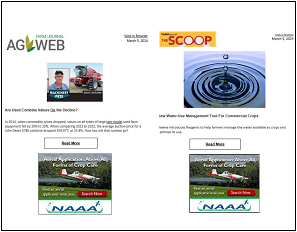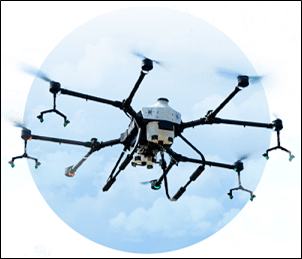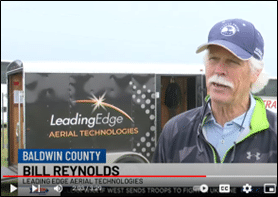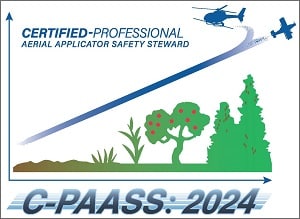Click on the article title below to be taken directly to the article. After you’re done reading the article, click “Back to Top” at the bottom to be brought back to the Table of Contents.
Table of Contents
- NAAA Continues to Target Hundreds of Thousands of Nationwide Ag Retailers & Farmers with Ad Buys in Farm Journal’s AgWeb & The Scoop
- Precedent-Setting Part 137 UAS Exemption Granted to Hylio
- New Coverage of Last Week’s 2nd Annual Spray Drone End User Conference
- AD Proposed for R44 Driveshaft Yoke
- C-PAASS Application Open – Become a 2024 Certified-Professional Aerial Applicator Safety Steward!
- Last Chance to Attend 2023-2024 PAASS!
NAAA Continues to Target Hundreds of Thousands of Nationwide Ag Retailers & Farmers with Ad Buys in Farm Journal’s AgWeb & The Scoop

NAAA has been actively promoting the benefits of aerial application services to farmers, ag retailers, and crop consultants across the United States through various advertising campaigns and articles in Farm Journal publications. This week, two advertisements targeted a potential circulation of 150,000 readers with the “Above All Other Forms of Crop Care,” ad featured in the March 5 edition of AgWeb, marking the beginning of a nine-week email advertising run in one of Farm Journal Media’s major newsletters. Additionally, this ad has appeared three times in The Daily Scoop eNewsletter this winter.
In 2024, NAAA is placing a significant focus on external communications through widely circulated Farm Journal Publications. This includes contributing a column to The Scoop’s monthly publication in four separate issues, promoting aerial application services, their benefits, and guiding readers on how to locate NAAA Member Operators through the Find an Aerial Applicator database. The first column, titled “Precision Technology Advancements in Aerial Application,” debuted in The Scoop’s February issue and The Daily Scoop eNewsletter, with the second column scheduled for the March 2024 edition. Sign up for a free copy of The Scoop’s magazine and eNewsletter to see these positive pieces on aerial application.
NAAA’s history of promoting aerial application services through national ads in agricultural trade media dates back to 2017. Last year, advertisements were placed in AgWeb, The Daily Scoop, and the CropLife News newsletter.
Precedent-Setting Part 137 UAS Exemption Granted to Hylio

Hylio, a U.S.-based agricultural uncrewed aircraft system (UAS) manufacturer, was recently granted a landmark exemption to conduct Part 137 swarm operations. Hylio initially petitioned to utilize their AG-230, an 8-gallon capacity octocopter marketed to produce up to a 35 ft swath width and treat up to 50 acres per hour at 1 GPA (if permitted on the label). Their FAA-granted exemption authorizes operations with any UAS identified in the List of Approved UAS under §44807.
Hylio was granted relief to operate up to three UAS under one operator, each weighing over 55 pounds, during night, and without visual observers (VOs), within visual line of sight (VLOS) of the pilot in command (PIC).
NAAA previously commented on the petition for this exemption, with the key concern of how these UAS will detect and avoid crewed aircraft conducting agricultural operations, potentially in adjacent fields. In their decision, the FAA cited Hylio’s radar-based Obstacle Avoidance system as a sufficient risk mitigation. They did not, however, respond to NAAA’s question on the system’s stated ON/OFF switch with which “the user is allowed to turn off avoidance to avoid unnecessary risk when they determine a mission is safe enough to fly without obstacle avoidance.” NAAA maintains that the ability to deactivate this system precludes it from being a reliable risk mitigation tool.
In the decision, FAA responded to NAAA concerns on diligent adherence to §137.37, which prohibits dispensing from an aircraft in a manner that creates a hazard to persons or property on the surface. NAAA questions the extent to which a single PIC can fulfill this obligation when tasked with operating three aircraft, potentially at night and without visual observers. In short, FAA cited the self-administered §137.19 knowledge and skills tests as a sufficient risk mitigation in addition to State pesticide licensure.
This exemption opens the door to disruptive change in the Part 137 UAS operations industry, with swarming markedly increasing efficiency potential and reducing needed manpower. This should, in turn, enable significantly more productive operations. What is still unclear is how state pesticide licensure authorities will handle these novel operations. While FAA seems content with the risk mitigations regarding airspace, will state departments of agriculture be content with a standard pesticide applicator license for one individual operating a swarm of sprayers?
You can view the FAA Decision here.
New Coverage of Last Week’s 2nd Annual Spray Drone End User Conference

As reported last week, NAAA participated in 2nd Annual Spray Drone End User Conference in Gulf Shores, Alabama. The conference was well attended by both national and international uncrewed aircraft system (UAS) manufacturers, UAS 14 CFR Part 137 certificate holders, and pesticide manufacturers—250 were in attendance with another 100 attending virtually. The local Fox News station covered the event, which you can view here. NAAA Allied member Bill Reynolds of Leading Edge Aerial Technologies was interviewed for the newscast.
NAAA CEO Andrew Moore attended the conference on behalf of the association and addressed the attendees about the NAAA’s long-time efforts working to ensure pesticides are labeled for aerial use, which EPA allows to be used for both crewed aircraft and UAS, without unnecessarily burdensome restrictions; safety policy NAAA advocates to avoid collisions between crewed aircraft and UAS; and business networking, educational stewardship programs, and positive public relations that NAAA provides to help ensure the economic health, professionalism and reputation of the industry.
AD Proposed for R44 Driveshaft Yoke
The FAA has proposed adopting a new AD for all Robinson Model R44 and R44 II helicopters. This proposed AD was prompted by reports of a fractured clutch shaft forward yoke (yoke) on the main rotor (M/R) drive due to fatigue cracking.
After receiving a report of a failed yoke in 2022, the FAA issued Special Airworthiness Information Bulletin (SAIB) AIR-22-08, which restated the importance of adhering to existing inspection procedures and maintenance manuals; according to the manufacturer, the yoke had fractured due to fatigue cracking and improper torque at the bolt hole and the yoke cross-section. After the FAA issued the SAIB, the manufacturer reported an additional incident where the yoke was fractured and separated from the drive train, again due to fatigue cracks and improper torquing.
The proposed AD would require, within 100 hours time-in-service (TIS), visual inspections of a certain part-numbered flex plate, yoke and yoke bolts, and depending on the inspection results, replacing an affected part. In addition, it would require replacing a certain part-numbered yoke after accumulating 2,200 hours TIS, or within 12 years since first installation, or as an alternative to removing the part from service, performing a 10X or higher power magnification visual inspection and, if needed, a magnetic particle inspection.
Comments on this proposed AD are due April 15, 2024.
C-PAASS Application Open – Become a 2024 Certified-Professional Aerial Applicator Safety Steward!

The 2024 Certified-Professional Aerial Applicator Safety Steward (C-PAASS) application is now open! This annual, individual certification for ag pilots, both operator and non-operator, serves to recognize a strong commitment to safety, professionalism and the pursuit of continuous improvement. Use it to positively distinguish yourself to insurers, customers, regulators and others outside the industry — and be a part of the force advancing safety, and changing the narrative, for agricultural aviation on a national level.
Individuals seeking 2024 certification will need to meet the following requirements:
New for 2024 and offered at no cost to NAAA members, NAAA and NAAREF have released the following two online courses listed below. Completion of each is required for 2024 certification. This is only the beginning. It is anticipated that future years will provide the opportunity for individuals to choose from a catalog of available courses for certification.
Avoiding Wire Strike Accidents
This 2-hour self-paced course is based on the 2022-2023 PAASS Program’s Human Factors module of the same title. It covers wire strike statistics, reconnaissance, forecasting and decision-making. (Course ID: 24-HF-01) Note: Individuals who have taken the Utilities / Aviation Specialists Flying in the Wire and Obstruction Environment course in-person within the last 12 months (at the Ag Aviation Expo, a state meeting, etc.) can waive this online course requirement upon request.
The Impact of Each Droplet – Part 1
This 30-minute self-paced course is a spray application primer in droplet size terminology and industry standards. Topics covered include droplet size statistics, droplet spectrum categories, coverage and drift potential. As the first course in a same-titled series, it lays the foundations for more in-depth courses centered around optimizing aerial spray applications. (Course ID: 24-EP-01)
You can check your C-PAASS eligibility anytime. Once you have completed all the component requirements, including the two courses above, you can apply online for 2024 C-PAASS! You can find more detailed instructions on applying here.
Last Chance to Attend 2023-2024 PAASS!

If you missed this year’s PAASS Program, you have one more chance. There will be a Zoom PAASS Program on Tuesday, March 12, from 9 a.m. to 1:30 p.m. CDT (10 a.m.–2:30 p.m. EDT). The cost is $900 per person.
Attend PAASS — The life you save might be your own.

